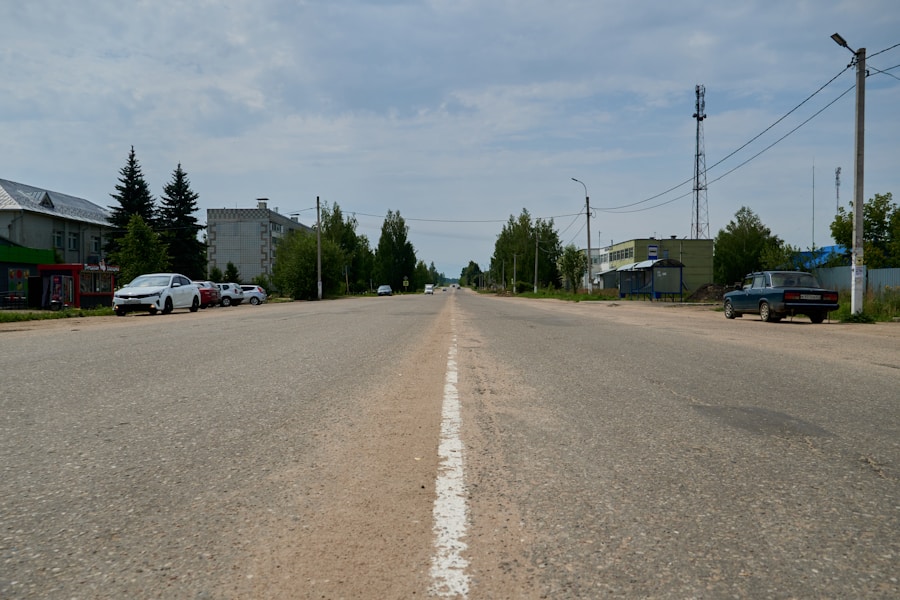Asphalt driveways are a popular choice for homeowners due to their durability and low maintenance. However, over time, they can start to show signs of wear and tear. Some common signs of wear and tear on an asphalt driveway include cracks, potholes, fading, and drainage issues. Cracks can occur due to the expansion and contraction of the asphalt during temperature changes, while potholes can form from water seeping into the cracks and freezing. Fading is a natural occurrence as the asphalt is exposed to the sun’s UV rays, and drainage issues can arise from improper installation or damage to the underlying base.
Another sign of wear and tear on an asphalt driveway is the appearance of raveling, which is when the surface of the asphalt starts to break down and become loose. This can be caused by a lack of proper maintenance, such as sealcoating, or heavy traffic on the driveway. Additionally, if you start to notice standing water on your driveway after a rainstorm, it could be a sign of poor drainage and potential damage to the underlying base. It’s important to address these signs of wear and tear as soon as possible to prevent further damage and extend the lifespan of your driveway.
Benefits and Drawbacks of Asphalt Overlay
One option for addressing the signs of wear and tear on an asphalt driveway is to apply an asphalt overlay. This involves adding a new layer of asphalt on top of the existing driveway to improve its appearance and functionality. One of the main benefits of an asphalt overlay is that it is a cost-effective solution compared to full reconstruction. It can also be completed relatively quickly, minimizing disruption to your daily routine. Additionally, an overlay can help to smooth out minor imperfections in the existing driveway, giving it a fresh and uniform appearance.
However, there are some drawbacks to consider with an asphalt overlay. For one, it may not be a suitable solution for driveways with extensive damage or structural issues. If the underlying base is compromised, an overlay may not provide a long-term solution. Additionally, an overlay will not address any drainage issues or underlying problems with the driveway, which could lead to further issues down the line. It’s important to weigh the benefits and drawbacks of an asphalt overlay before making a decision on how to address the wear and tear on your driveway.
Benefits and Drawbacks of Full Reconstruction
Another option for addressing wear and tear on an asphalt driveway is full reconstruction. This involves removing the existing asphalt and base material and starting from scratch with a new base and asphalt surface. One of the main benefits of full reconstruction is that it provides a long-term solution for addressing structural issues and drainage problems. It also allows for the opportunity to make any necessary improvements to the design or layout of the driveway.
However, there are some drawbacks to consider with full reconstruction. For one, it is a more expensive and time-consuming process compared to an overlay. It also requires more extensive labor and equipment, which can result in more disruption to your daily routine. Additionally, full reconstruction may not be necessary for driveways with minor wear and tear issues that can be addressed with less invasive methods. It’s important to carefully consider the benefits and drawbacks of full reconstruction before making a decision on how to address the signs of wear and tear on your driveway.
Cost Comparison
When considering how to address wear and tear on an asphalt driveway, cost is often a significant factor in the decision-making process. An asphalt overlay is generally a more cost-effective solution compared to full reconstruction. The materials and labor required for an overlay are typically less expensive than those needed for full reconstruction, making it a more budget-friendly option for homeowners. Additionally, an overlay can be completed relatively quickly, minimizing labor costs and disruption to your daily routine.
On the other hand, full reconstruction is a more expensive process due to the extensive labor and materials required. The removal of the existing asphalt and base material, as well as the installation of a new base and asphalt surface, can result in higher costs compared to an overlay. Additionally, full reconstruction may require additional expenses for addressing any underlying drainage issues or structural problems with the driveway. It’s important to carefully consider the cost comparison between an asphalt overlay and full reconstruction when deciding how to address wear and tear on your driveway.
Environmental Impact
In addition to cost considerations, it’s important to consider the environmental impact of different methods for addressing wear and tear on an asphalt driveway. An asphalt overlay is generally considered to have a lower environmental impact compared to full reconstruction. This is because an overlay requires less material and labor, resulting in fewer resources being used and less waste being generated. Additionally, an overlay can help to extend the lifespan of the existing driveway, reducing the need for frequent replacements and minimizing the environmental impact over time.
On the other hand, full reconstruction can have a higher environmental impact due to the extensive removal of existing materials and the use of new resources for the installation of a new base and asphalt surface. This process can result in more waste being generated and more resources being consumed compared to an overlay. However, full reconstruction does provide the opportunity to make any necessary improvements to the design or layout of the driveway, which could result in long-term environmental benefits. It’s important to carefully consider the environmental impact of different methods for addressing wear and tear on your driveway when making a decision.
Long-Term Durability
When considering how to address wear and tear on an asphalt driveway, it’s important to think about the long-term durability of different methods. An asphalt overlay can provide a relatively durable solution for addressing minor signs of wear and tear on a driveway. It can help to smooth out minor imperfections in the existing surface and extend the lifespan of the driveway without requiring extensive removal or replacement of materials.
However, an overlay may not provide a long-term solution for driveways with more extensive damage or structural issues. In these cases, full reconstruction may be necessary to ensure long-term durability and functionality. Full reconstruction allows for the installation of a new base and asphalt surface, providing a more robust solution for addressing underlying problems with the driveway. It’s important to carefully consider the long-term durability of different methods for addressing wear and tear on your driveway when making a decision.
Making the Right Choice for Your Driveway
Ultimately, when deciding how to address wear and tear on an asphalt driveway, it’s important to carefully weigh the benefits and drawbacks of different methods. Consider factors such as cost, environmental impact, long-term durability, and the extent of damage to your driveway when making a decision. An asphalt overlay can be a cost-effective and relatively quick solution for addressing minor signs of wear and tear, while full reconstruction may be necessary for driveways with more extensive damage or structural issues.
It’s also important to consult with a professional contractor who can assess the condition of your driveway and provide recommendations for the best course of action. They can help you understand the extent of damage to your driveway and provide guidance on whether an overlay or full reconstruction is the most suitable solution. By carefully considering these factors and seeking professional advice, you can make an informed decision on how to address wear and tear on your asphalt driveway and ensure its long-term functionality and durability.

